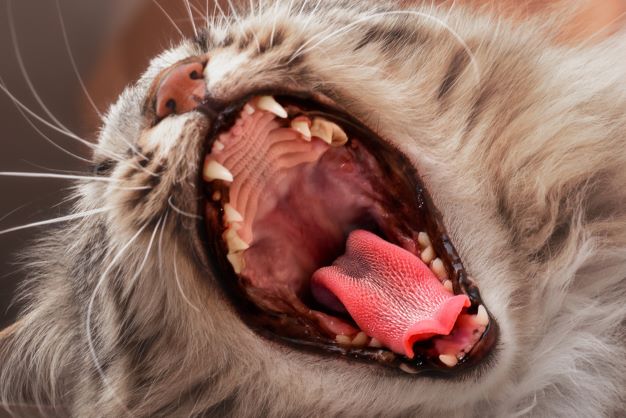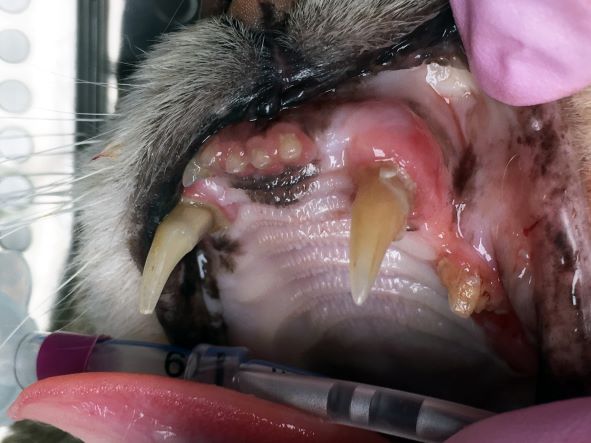The UK’s largest ever feline dental disease study identifies age and breed as biggest risk factors
New research from the Royal Veterinary College (RVC) has shed light on the frequency, risk factors and linked health problems associated with periodontal disease in pet cats in the UK. These findings will help veterinary practitioners and owners better understand and predict its occurrence and identify opportunities to improve cats’ dental health.

Periodontal disease is the most commonly diagnosed disease in UK cats. The study found 15.2% of cats are diagnosed annually (estimated 1.8 million cats affected every year in the UK), with many more likely going undiagnosed. Periodontal disease causes a range of oral health issues, including gum inflammation, attachment loss of the structures supporting the teeth, tooth mobility, and pain. The early stages include gingivitis (gum inflammation) which can be reversed with good oral health treatment. However, if left untreated, gingivitis can progress to periodontitis (end stage gum disease) which is very difficult to resolve and can lead to teeth loss.
Although periodontitis can be painful, it can be difficult to identify because cats have developed evolutionary survival habits of masking chronic pain from potential predators. Until now, research on dental problems in companion animals has mostly been in dogs, so there has been limited understanding of periodontal disease in cats.
The study, led by the RVC’s VetCompass Programme, is the largest study ever carried out into dental disease in cats using veterinary clinical records. The study investigated a sample of 18,249 cats randomly selected from a study population of 1,255,130 cats in the UK in 2019. Formally recorded in 15.2% of cats, periodontal disease was the most common disorder in the cats in the study. The cat breeds with the highest annual levels of this diagnosis were Siamese (18.7%), Maine Coon (16.7%) and British Short Hair (15.5%) as well as crossbreeds (15.4%). The average bodyweight of cats with periodontal disease (5.7kg) was higher than for cats without periodontal disease (5.5kg).
The risk of periodontal disease rose steeply as cats got older, with cats aged 9 to 12 years being 6.7 times more likely to have periodontal disease compared with cats aged under 3 years. This highlights the importance for owners taking extra dental care of their cats as they age.

Cats with periodontal disease were much more likely to have a range of other health conditions compared to cats without periodontal disease (x 1.8 risk). Of the 40 other most diagnosed disorders in cats in the study, cats with periodontal disease were more likely to have 21 (52.5%) of these compared to cats without periodontal disease. These conditions included cardiac dysrhythmia (x 2.3 risk), ear discharge (x 2.3 risk) and hairball/furball (x 2.3 risk).
These findings suggest that periodontal disease should be acknowledged as a leading health and welfare issue in cats. The results indicate that age is a strong predictor of periodontal disease risk in cats, indicating a need for greater dental care in cats as they age. This information will help owners provide targeted care for their cats and veterinary teams focus on preventative healthcare methods.
The study also shows the value of Big Data resources such as VetCompass to increase our overall understanding of cat health at a population level.
Dan O’Neill, Associate Professor in Companion Animal Epidemiology at the RVC and lead author of the paper, said:
“Although everyone who loves cats wants to make their lives happier and healthier, sadly we often are not even aware when our cats are suffering from dental pain. This study helps owners to understand how common and serious dental problems are for cats.
“There are many ways owners can help support their good oral health in cats. This includes establishing a routine, brushing at roughly the same time each day and using a veterinary/cat toothpaste which is safe for your pet. It is important to start gradually to allow your cat to get used to the taste and accustomed to having their mouth opened before attempting brushing. If you are in doubt about the health of your cat’s teeth, please do ask your vet for advice.”
Alix Freeman, Clinician in dentistry, oral and maxillofacial surgery at Eastcott Referrals, said:
“As a veterinary dentist, I see periodontal disease and its effects in cats on a daily basis. I see the huge welfare impact this infectious disease has on our patients. It is wonderful that this research will help draw attention to periodontal disease and the associated health concerns. Prevention is the key to management of periodontal disease. In the same way that humans brush their teeth twice daily, periodontitis can largely be prevented in cats if we institute toothbrushing on a daily basis from a young age. Electric toothbrushes are very useful for effective homecare in cats. Special dental diets, dental treats, chews, water additives and supplements can all help maintain oral health but are no substitute for effective brushing. Regular health checks with your veterinarian will help identify problems at an early stage to ensure the best outcomes.”
Justine Shotton, Senior Vice President of the British Veterinary Association said:
“Cats are excellent at letting us know when they want food or affection but rarely make it clear when they are in pain. Unfortunately, this means that issues can be quite advanced by the time they reach the vet practice and treatment options may be limited or costly. Although it may sound daunting, owners can play a key role in their cats’ long-term oral health by introducing a routine of regular brushing. If you’re struggling to brush your cats’ teeth or have concerns about their dental health, it’s important to visit your vet early and explore solutions before severe problems develop.”
This study was supported by an award from the Kennel Club Charitable Trust and Agria Pet Insurance.
Notes to Editors
Reference
O’Neill et al. (2023) “Periodontal disease in cats under primary veterinary care in the UK: frequency and risk factors”, Journal of Feline Medicine and Surgery
The full paper is available here: https://doi.org/10.1177/1098612X231158154 and https://journals.sagepub.com/doi/full/10.1177/1098612X231158154.
An infographic that summarises the main findings from the study is available at http://www.rvc.ac.uk/Media/Default/VetCompass/Infograms/230224%20Periodontal%20disease%20in%20cats.pdf
For media enquiries, please contact:
- Jasmin De Vivo (jasmin.devivo@plmr.co.uk) or rvc@plmr.co.uk
- Press Line: 0800 368 9520
About the RVC
- The Royal Veterinary College (RVC) is the UK's largest and longest established independent veterinary school and is a Member Institution of the University of London.
- It is one of the few veterinary schools in the world that hold accreditations from the RCVS in the UK (with reciprocal recognition from the AVBC for Australasia, the VCI for Ireland and the SAVC for South Africa), the EAEVE in the EU, and the AVMA in the USA and Canada.
- The RVC is ranked as the top veterinary school in the world in the QS World University Rankings by subject, 2022.
- The RVC offers undergraduate and postgraduate programmes in veterinary medicine, veterinary nursing and biological sciences.
- The RVC is a research led institution with 88% of its research rated as internationally excellent or world class in the Research Excellence Framework 2021.
- The RVC provides animal owners and the veterinary profession with access to expert veterinary care and advice through its teaching hospitals and first opinion practices in London and Hertfordshire.

